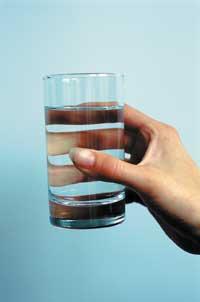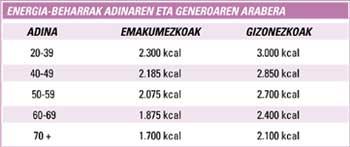Adult feeding

The body changes in this period, especially from the age of fifty, decreasing body muscle mass and increasing the amount of fat in general. In women it is the time of menopause, in which the body produces less estrogen hormone and therefore decreases bone mass, so in this time you have to take care especially of bones.
Given these bodily changes, feeding should adapt to the new situation. The first measure to take is the reduction of calories if we do not want to fatten, but ensuring that the needs of vitamins and mineral salts are covered. In fact, in this age group women need more mineral salt than in others, except for iron. In the latter case, from the age of fifty the woman has 10 mg of iron per day, like the man, and until then needs 18 mg per day. The following table shows the reduction of energy needs from one decade to another.
As already indicated, at this time of life, the most important goal is to maintain health and, above all, care for the intestines, kidneys and liver. To do this, among other things, we must try to drink enough water daily. The body usually asks for less and less water, but that does not mean it should not, since changes in the body reduce the feeling of thirst.
As for the intestines, simple carbohydrates released in digestion, fatty acids, amino acids, vitamins and mineral salts pass through the intestine to the blood. In addition, the intestines work as a barrier, avoiding the entry of toxins and pathogenic microorganisms. When the state of the intestine changes, it increases its permeability, which facilitates the arrival of toxic substances into the blood.

In intestinal health two factors intervene, the number of bacteria and the state of the intestinal mucous membrane, which are the direct effects of food. What can we do to improve intestinal health? Eat bacteria that contain fiber, fructooligosaccharides, and certain foods.
Fructooligosaccharides are carbohydrates that contain honey, onions, asparagus, rye, oats, artichokes and bananas, allowing an increase of beneficial bacteria in the intestine, such as bifidobacteria and lactobacilli, which eliminate pathogenic bacteria Salmonella and Clostridium.
There are foods on the market that contain bifidobacteria and other bacteria, such as dairy. These reduce intestinal pH and thus reduce the possibility of forming pathogenic bacteria. Some medicines, especially antibiotics, remove all gut bacteria, good and bad, and dairy products containing bifidobacteria are very good at restoring balance.
At this stage of life we need, in addition to the usual nutritious ingredients, non-nutritious phytochemical ingredients found in vegetables, fruits and green beans. Thanks to them problems such as phytochemical components of soy are avoided, especially good for women who approach menopause, as they help overcome symptoms (heat, sweat…). At the same time, soy genistein helps fight osteoporosis, as it performs the same function as the first estrogens, that is, excites osteoblasts, bone producing cells.

Learning to live
It is never too late to improve and much less to take care of health. Childhood and adolescence are the best times to adopt dietary habits, but we can always adapt our diet to maturity, either by prescription of the ingredients, or because thanks to new research we have known something more. In fact, they are continually being investigated.
Some are very broad and long-term, like the EPIC study being conducted in nine European countries to analyze the relationship between food and cancer, others are smaller and analyze between 700 and 1,000 surveys. These small investigations, despite their simplicity, are important and useful in adapting health advice to local reality.

All these research aims to detect factors that directly affect health and provide dietary advice from them. An example of this is the study conducted by Ancel Keys and his companions on the Mediterranean diet and heart disease. This study showed that the most suitable diet to avoid heart problems and blood circulation was the Mediterranean. These studies allow adaptations in food production to make healthier foods (already mentioned in the February article milk with omega-3 fat or biscuits with fiber).
These changes are leading to the emergence of new concepts in this functional diet, such as prebiotic and probiotic foods. Prebiotics give rise to a healthy state, such as foods containing fiber and fructooligosaccharides. Probiotics, for their part, contribute to the introduction of healthy bacteria (conventional and fermented dairy, for example).
According to the report “Healthy people of 2000” prepared by the U.S. Department of Health and Human Services, 50% of chronic diseases can be avoided with an adequate life. Therefore, we will have to be attentive to future research to know whether or not we should introduce changes in the longest stage of life.





